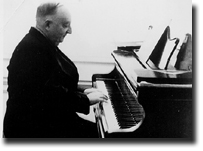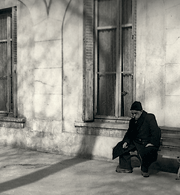Gurdjieff/deHartmann Music
 “When he was at the Prieuré, Mr Gurdjieff worked with me a great deal on music, but not for Movements. Beginning in July 1925 he began to create another kind of music, which flowed richly from him during the next two years.
“When he was at the Prieuré, Mr Gurdjieff worked with me a great deal on music, but not for Movements. Beginning in July 1925 he began to create another kind of music, which flowed richly from him during the next two years.
“I had a very difficult and trying time with this music. Mr Gurdjieff sometimes whistled or played on the piano with one finger a very complicated sort of melody-as are all Eastern melodies, although they seem at first to be monotonous. To grasp this melody, to transcribe it in European notation, required a tour de force.
“How it was written down is very interesting in itself. It usually happened in the evening, either in the big salon of the château or in the Study House. From my room I usually heard when Mr Gurdjieff began to play and, taking my music paper, I had to rush downstairs. All the people came soon and the music dictation was always in front of everybody.
“It was not easy to notate. While listening to him play, I had to scribble down at feverish speed the tortuous shifts and turns of the melody, sometimes a repetition of just two notes. But in what rhythm? How to mark the accentuation? There was no hint of conventional Western metres and tuning. Here was some sort of rhythm of a different nature, other divisions of the flow of melody, which could not be interrupted or divided by bar-lines. And the harmony -the Eastern tonality on which the melody was constructed- could only gradually be guessed.
“It is true that Mr Gurdjieff would repeat several sections, but often-to vex me, I think-he would begin to repeat the melody before I had finished writing it, and usually with subtle differences and added embellishments, which drove me to despair. Of course, it must be remembered that this was not only a means of recording his music for posterity, but equally a personal exercise for me to ‘catch’ and ‘grasp’ the essential character, the very noyau, or kernel, of the music. And, I might add, this ‘catching the essence’ applied not only to music. For me it was a constant difficulty, a never-ending test.
“When the melody was written, Mr Gurdjieff would tap on the lid of the piano a rhythm on which to build the accompaniment, which in the East would be played on some kind of percussion instrument. The entire melody, as given, would somehow have to blend with the background of this rhythm, but without ever being changed or adjusted to fit the accompaniment. And then I had to perform at once what had been given, improvising the harmony as I went. When I began the work of harmonizing the melodies, I very soon came to understand that no free harmonization was possible. The genuine true character of the music is so typical, so ‘itself,’ that any alterations would only destroy the absolutely individual inside of every melody.
“Once Mr Gurdjieff said to me very sharply, ‘It must be done so that every idiot could play it.’ But God saved me from taking these words literally and from harmonizing the music as pieces are done for everybody’s use. Here at last is one of the examples of his ability to ‘entangle’ people and to make them find the right way themselves by simultaneous work-in my case, notation of music and at the same time an exercise for catching and collecting everything that would be very easy to lose.
“It gradually became Mr Gurdjieff’s custom, when he returned from Paris, to work with me on new music notation. After supper, when everyone was gathered together, the most recently harmonized music was played, then the latest text of Beelzebub was read, after which music was played again.
“Mr Gurdjieff’s music had great variety. The most deeply moving was that which he remembered hearing in remote temples during his Asian travels. Listening to this music one was touched to the depth of his being …”
Thomas de Hartmann, from Our Life with Mr. Gurdjieff by Thomas and Olga de Hartmann

